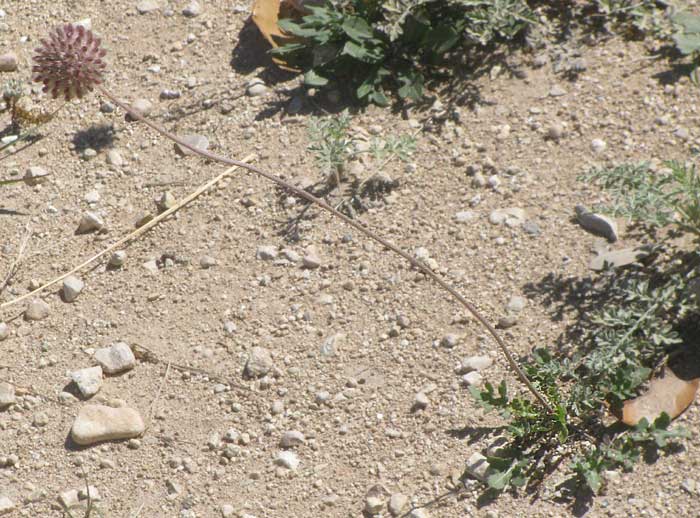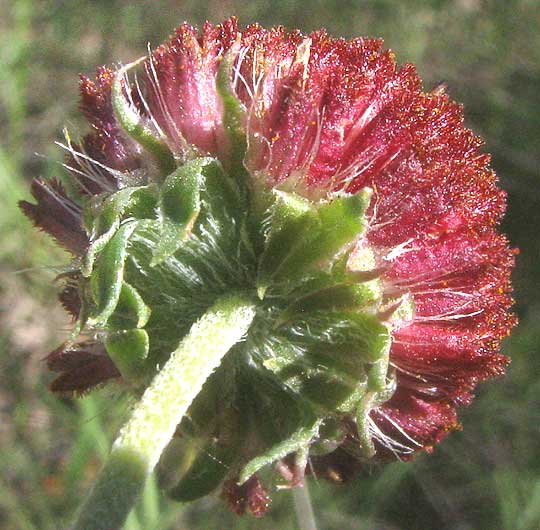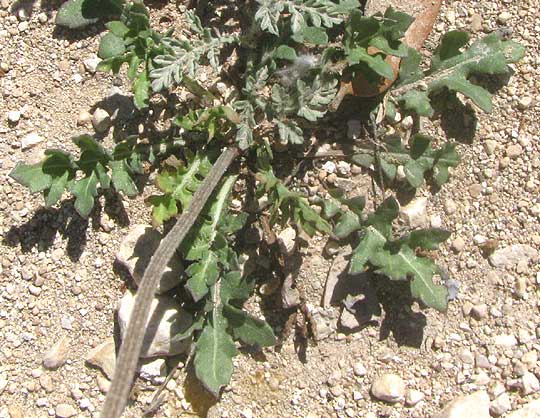Excerpts from Jim Conrad's
Naturalist Newsletter

from the the May 12, 2013 Newsletter issued from the Frio Canyon Nature Education Center in northern Uvalde County, southwestern Texas, on the southern border of the Edwards Plateau; elevation ~1750m (~5750 ft); N29.62°, W99.86°; USA
PINCUSHION DAISIES
At roadsides in some of the driest, thinnest, most unaccommodating-looking dirt imaginable, a certain 15-inch-tall (40cm) plant has been catching my attention for some time. It consists of nothing but a spherical cluster of tightly packed blossoms, for it's a member of the Daisy or Composite Family, atop a stiff, slender stem arising from a meager rosette of deeply lobed, dandelion-like leaves. A typical plant is shown above.
I've been waiting for ray flowers to develop before I took a closer look, but finally I noticed that butterflies frequently visit the rayless heads, apparently taking nectar from mature flowers. It turns out that this is one of those rare Daisy Family members lacking petal-like ray flowers, and whose cylindrical disc flowers are packed into a spherical head. A close-up of a flower head is shown below:

In that picture you see many cylindrical, purplish-red disc flower corollas packed side by side. From their tops emerge fuzzy, pollen-collecting style branches with stigmatic surfaces, and at the base of the corollas arise pale scales tipped with needle-like bristles or "aristae," which constitute the pappi atop the developing fruits, or cypselae. The most commonly encountered pappi type are white hairs, like those that become the fuzz atop parachuted dandelion fruits, and many Daisy Family members have no pappi at all, so such pappi as these are a little unusual.
A closer look at the basal cluster of lobed leaves can be seen below:

With so many unusual features, this wildflower was easily determined to be a species going by several common names such as Pincushion Daisy, Rayless Gaillardia, Fragrant Gaillardia and Perfumeballs. It's GAILLARDIA SUAVIS, especially adapted to calcareous and sandy soils of prairies, desert scrub, and juniper woodlands like ours. They occur in arid northeastern Mexico and in the US from Texas north to Kansas.
Another unusual feature about Pincushion Daisies I didn't know about until I read it is that many individuals of the species do indeed produce petal-like ray flowers causing the flower heads to look like those of typical daisies. In fact, most pictures of the species on the Internet show heads with ray flowers. All the ones I've noticed are rayless. Maybe it's because of our severe drought, or maybe our local ones simply tend to not produce rays.
Also I was surprised by the Pincushion Daisy's other common names alluding to the flowers' fragrance. During my visits I've not noticed any aroma. Maybe it was too windy or maybe I just stayed upwind from them. But I read that they smell of gardenia. Certainly butterflies are attracted to the heads.